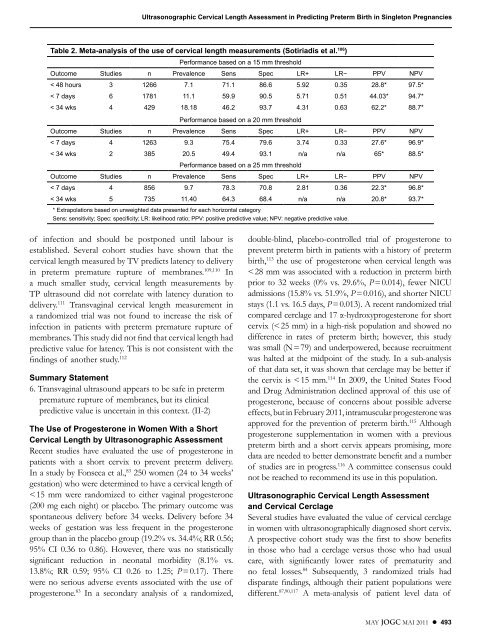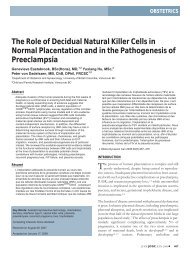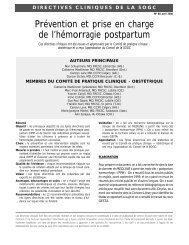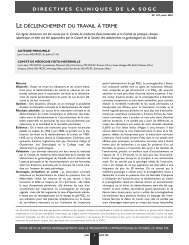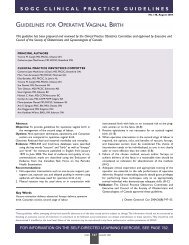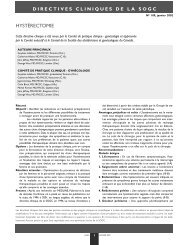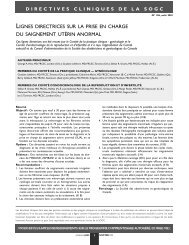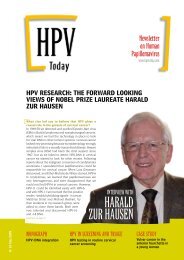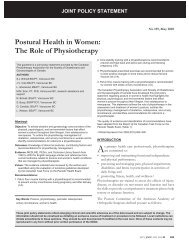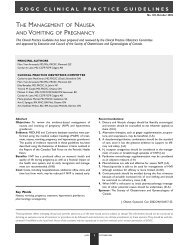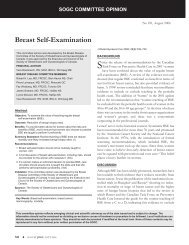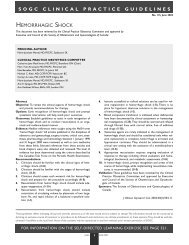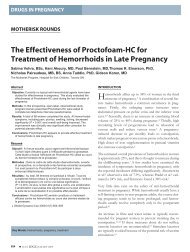Ultrasonographic Cervical Length Assessment in Predicting ... - SOGC
Ultrasonographic Cervical Length Assessment in Predicting ... - SOGC
Ultrasonographic Cervical Length Assessment in Predicting ... - SOGC
Create successful ePaper yourself
Turn your PDF publications into a flip-book with our unique Google optimized e-Paper software.
of <strong>in</strong>fection and should be postponed until labour is<br />
established. Several cohort studies have shown that the<br />
cervical length measured by TV predicts latency to delivery<br />
<strong>in</strong> preterm premature rupture of membranes. 109,110 In<br />
a much smaller study, cervical length measurements by<br />
TP ultrasound did not correlate with latency duration to<br />
delivery. 111 Transvag<strong>in</strong>al cervical length measurement <strong>in</strong><br />
a randomized trial was not found to <strong>in</strong>crease the risk of<br />
<strong>in</strong>fection <strong>in</strong> patients with preterm premature rupture of<br />
membranes. This study did not f<strong>in</strong>d that cervical length had<br />
predictive value for latency. This is not consistent with the<br />
f<strong>in</strong>d<strong>in</strong>gs of another study. 112<br />
Summary Statement<br />
6. Transvag<strong>in</strong>al ultrasound appears to be safe <strong>in</strong> preterm<br />
premature rupture of membranes, but its cl<strong>in</strong>ical<br />
predictive value is uncerta<strong>in</strong> <strong>in</strong> this context. (II-2)<br />
The Use of Progesterone <strong>in</strong> Women With a Short<br />
<strong>Cervical</strong> <strong>Length</strong> by <strong>Ultrasonographic</strong> <strong>Assessment</strong><br />
Recent studies have evaluated the use of progesterone <strong>in</strong><br />
patients with a short cervix to prevent preterm delivery.<br />
In a study by Fonseca et al., 83 250 women (24 to 34 weeks’<br />
gestation) who were determ<strong>in</strong>ed to have a cervical length of<br />
< 15 mm were randomized to either vag<strong>in</strong>al progesterone<br />
(200 mg each night) or placebo. The primary outcome was<br />
spontaneous delivery before 34 weeks. Delivery before 34<br />
weeks of gestation was less frequent <strong>in</strong> the progesterone<br />
group than <strong>in</strong> the placebo group (19.2% vs. 34.4%; RR 0.56;<br />
95% CI 0.36 to 0.86). However, there was no statistically<br />
significant reduction <strong>in</strong> neonatal morbidity (8.1% vs.<br />
13.8%; RR 0.59; 95% CI 0.26 to 1.25; P = 0.17). There<br />
were no serious adverse events associated with the use of<br />
progesterone. 83 In a secondary analysis of a randomized,<br />
<strong>Ultrasonographic</strong> <strong>Cervical</strong> <strong>Length</strong> <strong>Assessment</strong> <strong>in</strong> Predict<strong>in</strong>g Preterm Birth <strong>in</strong> S<strong>in</strong>gleton Pregnancies<br />
Table 2. Meta-analysis of the use of cervical length measurements (Sotiriadis et al. 106 )<br />
Performance based on a 15 mm threshold<br />
Outcome Studies n Prevalence Sens Spec LR+ LR− PPV NPV<br />
< 48 hours 3 1266 7 .1 71 .1 86 .6 5 .92 0 .35 28 .8* 97 .5*<br />
< 7 days 6 1781 11 .1 59 .9 90 .5 5 .71 0 .51 44 .03* 94 .7*<br />
< 34 wks 4 429 18 .18 46 .2 93 .7 4 .31 0 .63 62 .2* 88 .7*<br />
Performance based on a 20 mm threshold<br />
Outcome Studies n Prevalence Sens Spec LR+ LR− PPV NPV<br />
< 7 days 4 1263 9 .3 75 .4 79 .6 3 .74 0 .33 27 .6* 96 .9*<br />
< 34 wks 2 385 20 .5 49 .4 93 .1 n/a n/a 65* 88 .5*<br />
Performance based on a 25 mm threshold<br />
Outcome Studies n Prevalence Sens Spec LR+ LR− PPV NPV<br />
< 7 days 4 856 9 .7 78 .3 70 .8 2 .81 0 .36 22 .3* 96 .8*<br />
< 34 wks 5 735 11 .40 64 .3 68 .4 n/a n/a 20 .8* 93 .7*<br />
* Extrapolations based on unweighted data presented for each horizontal category<br />
Sens: sensitivity; Spec: specificity; LR: likelihood ratio; PPV: positive predictive value; NPV: negative predictive value .<br />
double-bl<strong>in</strong>d, placebo-controlled trial of progesterone to<br />
prevent preterm birth <strong>in</strong> patients with a history of preterm<br />
birth, 113 the use of progesterone when cervical length was<br />
< 28 mm was associated with a reduction <strong>in</strong> preterm birth<br />
prior to 32 weeks (0% vs. 29.6%, P = 0.014), fewer NICU<br />
admissions (15.8% vs. 51.9%, P = 0.016), and shorter NICU<br />
stays (1.1 vs. 16.5 days, P = 0.013). A recent randomized trial<br />
compared cerclage and 17 α-hydroxyprogesterone for short<br />
cervix (< 25 mm) <strong>in</strong> a high-risk population and showed no<br />
difference <strong>in</strong> rates of preterm birth; however, this study<br />
was small (N = 79) and underpowered, because recruitment<br />
was halted at the midpo<strong>in</strong>t of the study. In a sub-analysis<br />
of that data set, it was shown that cerclage may be better if<br />
the cervix is < 15 mm. 114 In 2009, the United States Food<br />
and Drug Adm<strong>in</strong>istration decl<strong>in</strong>ed approval of this use of<br />
progesterone, because of concerns about possible adverse<br />
effects, but <strong>in</strong> February 2011, <strong>in</strong>tramuscular progesterone was<br />
approved for the prevention of preterm birth. 115 Although<br />
progesterone supplementation <strong>in</strong> women with a previous<br />
preterm birth and a short cervix appears promis<strong>in</strong>g, more<br />
data are needed to better demonstrate benefit and a number<br />
of studies are <strong>in</strong> progress. 116 A committee consensus could<br />
not be reached to recommend its use <strong>in</strong> this population.<br />
<strong>Ultrasonographic</strong> <strong>Cervical</strong> <strong>Length</strong> <strong>Assessment</strong><br />
and <strong>Cervical</strong> Cerclage<br />
Several studies have evaluated the value of cervical cerclage<br />
<strong>in</strong> women with ultrasonographically diagnosed short cervix.<br />
A prospective cohort study was the first to show benefits<br />
<strong>in</strong> those who had a cerclage versus those who had usual<br />
care, with significantly lower rates of prematurity and<br />
no fetal losses. 84 Subsequently, 3 randomized trials had<br />
disparate f<strong>in</strong>d<strong>in</strong>gs, although their patient populations were<br />
different. 87,90,117 A meta-analysis of patient level data of<br />
MAY JOGC MAI 2011 l 493


